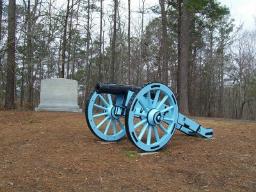 |
| Pea Ridge National Military Park |
Today marks the 150th Anniversary of the first day of the Battle of Pea Ridge, Arkansas.
Also called the Battle of Elkhorn Tavern, the engagement at Pea Ridge began when the morning of March 7, 1862, revealed Major General Earl Van Dorn's Confederate army moving in full force around the right flank of Major General Samuel Curtis's entrenched Union army.
Having fought with Federal troops near Bentonville the previous day and then sending part of his force up the Telegraph or Wire Road after them to keep up the impression that he intended a frontal attack on the Union army, Van Dorn moved out on a long, difficult and exhausting night march via a route called the Bentonville Detour. This road passed was a cut-off of sorts that connected Bentonville with the Telegraph Road just north of the Pea Ridge Battlefield.
 |
| Gen. Ben McCulloch, CSA |
Van Dorn's plan was to strike Curtis on the right flank and rear. The commanding general himself accompanied the division of Major General Sterling Price, which followed the detour all the way around the Union army until it struck the Telegraph Road. In heavy force, Price and his men then began an advance south towards Elkhorn Tavern intending to hit Curtis from behind.
The other division was commanded by Brigadier General Ben McCulloch. He was to hit the right flank of the Union army as Price came down to strike it in the rear. If all went well, Van Dorn would smash Curtis and either force his surrender, put his men into flight into the mountains where they could not be supplied or drive them into Little Sugar Creek, which they were facing.
It didn't go as hoped. The road was long and hard and conditions were bad. The Confederate infantry spent the night trudging through cold mud and shivering in the winter weather of the Ozark Plateau. The supply wagons were far in the rear and as the march continued through the night, the distance between them and the main fighting force grew and grew.
 |
| Gen. Samuel Curtis, USA |
Sunrise came and Van Dorn was not in position to begin his attack. The Federals observed his troops moving around their right and began to adjust accordingly. Even so, the surprise move almost ended in victory for the Confederates.
Convening a meeting of his officers at the tent of Brigadier General Alexander Asboth, Curtis ordered his commanders to begin a complete change of front of his army. This was a remarkable thing to attempt under any conditions, but with an enemy attack pending it was intensely difficult and dangerous. The Union commander, however, had no choice.
 |
| Col. Grenville Dodge, USA |
As this meeting was underway, a courier arrived to report that Confederate troops could be seen moving in force along the Ford road to the west. Colonel Peter Osterhaus was ordered to move with his division to probe the movement. As Osterhaus began to move his men to the west in the direction of Leetown, a small community on the battlefield, a second courier arrived to report that a second body of Confederates was moving south in force on the Telegraph Road, aiming for Elkhorn Taver and the Union supply trains.
Colonel Grenville Dodge's brigade was just outside the tent at the time and Curtis order Dodge's commander, Colonel Eugene Carr, to take Dodge's brigade and half the Confederate force advancing down the Telegraph Road. Carr moved out promising the battle would be over in an hour.
 |
| Leetown Battlefield at Pea Ridge National Military Park |
Osterhaus struck first, engaging the Confederates under McCulloch near Leetown and finding them to be in greatly superior force. Ordering his division forward, McCulloch began to push back the Federals. General Curtis ordered Colonel Jefferson C. Davis (not to be confused with Confederate President Jefferson Davis) to march to the support of Osterhaus and his men.
Almost simultaneously, Price attacked Union forces on the northern end of the battle, deploying his division out on both sides of Telegraph Road and pushing for Elkhorn Tavern. The Battle of Pea Ridge was now underway:
 |
| Col. Jefferson C. Davis, USA |
...The battle raged...with terrible fury. Colonel Davis held the position against fearful numbers, and our brave troops nobly stood or charged in steady lines. The fate of the battle depended on success agaisnt this flank movement of the enemy [i.e. the movement by McCulloch against the Union right], and here near Leetown was the place to break it down. - Gen. Samuel Curtis, USA, April 1, 1862.
It in the woods and fields near Leetown that disaster struck the Confederate army. Realizing that the Federal forces opposing him were growing in strength, General McCulloch came up to view the Union lines in person before launching a major attack against them when he was shot down. So ended the life of on of the most remarkable men in the history of Texas, the South and the United States.
 |
| Gen. James McIntosh, CSA |
Command of the division now fell to Brigadier General James McIntosh, but within fifteen minutes he too was shot down just a short distance from where McCulloch had been killed. He died on the battlefield, becoming the first Confederate general from Florida to give his life in the cause of the South.
Colonel Louis Hebert, of Louisiana, now assumed the command and ordered the attack. It went well at first and the Federals were driven back. Smoke, friendly fire and wooded terrain, however, created great confusion in the Confederate ranks and the attack stalled. Hebert became separated from his men and was taken prisoner.
Please click here to continue to The Battle of Pea Ridge, Arkansas - Day One, Part Two.
You also can read more at
www.exploresouthernhistory.com/pearidgeindex.



















































